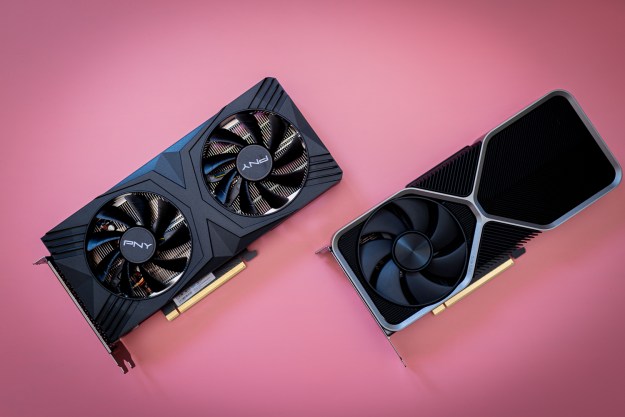Nvidia’s Deep Learning Super Sampling (DLSS) is getting a huge boost. The new DLSS 3.5 update adds a feature called Ray Reconstruction to the suite, and it promises to make ray tracing more realistic than ever before. I’ve tested it, and Nvidia was telling the truth.
Ray Reconstruction brings ray tracing to new heights of realism, and it’s a fantastic addition to the DLSS suite. Even better, it works across all RTX graphics cards, unlike Nvidia’s DLSS Frame Generation. However, there could be a problem with support as we see more games release with the feature. Ray Reconstruction may work with any RTX GPU, but it could be a feature that’s only realistic for intensive ray tracing that requires one of the latest and greatest GPUs.
What ray tracing should be
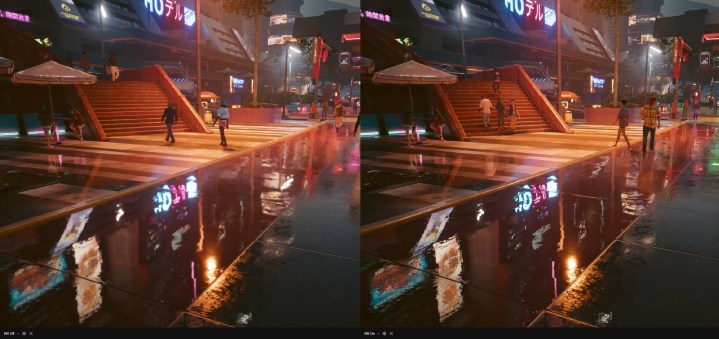
The best showcase of DLSS 3.5 is what you can see above. These screenshots were taken from Japantown West in Cyberpunk 2077, which is one of the locations Nvidia recommended taking a look at. With Ray Reconstruction turned on, the clarity of the reflection shoots through the roof. Keep in mind that this isn’t a more intensive form of ray tracing — I saw identical performance with Ray Reconstruction turned off. For the image above, and all of the images below, the version with Ray Reconstruction is on the right.

That’s one of Nvidia’s cherry-picked scenes, but what about everywhere else? Cruising around Pacifica, I spotted this weird, hexagon-shaped piece of machinery. Turning on Ray Reconstruction is like a revelation. The original version implies a reflection of some poles around the street, but it’s blurry. Ray Reconstruction makes it sharp, calling back to the reflection of fire in the eye of a solider when we originally saw ray tracing in Battlefield V.
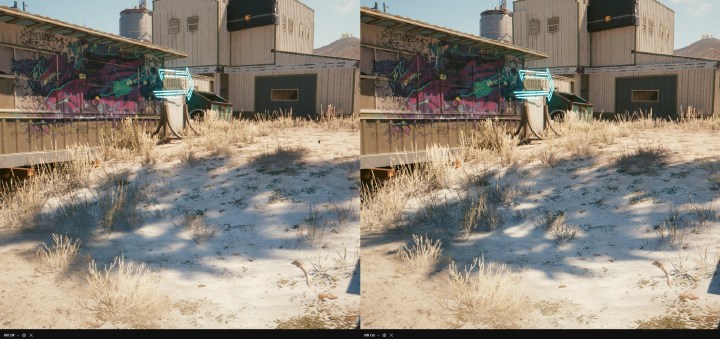
Reflections are where DLSS 3.5 is most obvious, and I’ll dig into why that’s the case a bit later on. It’s not just mirror-like surfaces where you see the impact, though. Venturing out into the Badlands, away from rain-slicked streets and neon lights, you can still see DLSS 3.5 at work. The shadow of the tree may look similar at first glance, but look at the dying patches of grass it’s covering. Ray Reconstruction renders the shadows much more accurately. There’s various levels of depth in the version with Ray Reconstruction, while the original version looks like a static shade of gray.
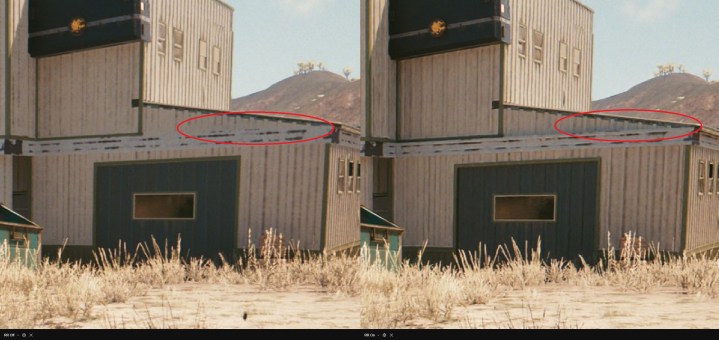
Looking closer at this scene, we can see DLSS 3.5 bolster ambient occlusion as well. The metal sheeting on the side of the building shows depth with Ray Reconstruction turned on, and the beam that surrounds the base of the roof casts a soft shadow.
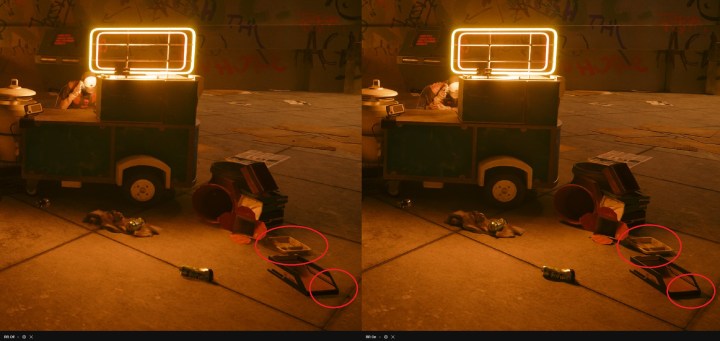
This intensity of shadows and reflections is the main draw of Ray Reconstruction. In the scene above, taken at night near the City Center, look at the shadows cast by the boxes on the ground. The intense light from the cart creates a direct, dark shadow for the pieces of trash with Ray Reconstruction. With the feature off, there’s only a hint of a shadow.
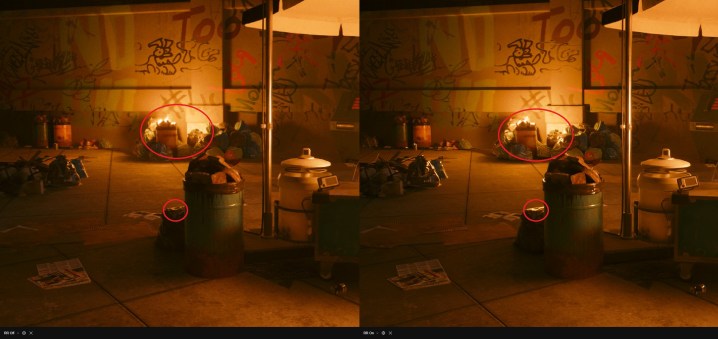
In this scene, we can see the boost to the intensity of reflections, even if they aren’t reflecting bright neon lights. The fire in the back of the scene shows an intense specular light on the trash immediately next to it, as well as the garbage can near the cart. Again, these effects are implied with DLSS 3.5 off, but they look much more accurate with the feature turned on.
Digging deeper

Now that we’ve dug into what Ray Reconstruction can do for your game visuals, let’s talk about how it works. As mentioned, Ray Reconstruction is an additional feature in the DLSS suite that you can turn on or off through the graphics menu. It works on all RTX graphics cards as well, so you don’t technically need an RTX 40-series GPU like RTX 4090 to use it (more on that technicality in the next section).
Ray Reconstruction all comes down to denoising. In order to run ray tracing in real time, games only calculate a sample of the rays that are being bounced around a scene. This leads to some pixels that have no information because the light calculation never reached that area. The end result is an image that looks like a grainy photo.
The most accurate solution is to simply cast more rays per pixel, but this takes a long time and is computationally expensive. In other words, it’s not feasible for playing games at 60 frames per second (fps). Instead, games employ denoisers to clean up the image. The two main methods are spatial reconstruction, where the denoiser fills in missing pixels with data from neighboring pixels, and temporal reconstruction, where two frames are compared to estimate the missing details.
Both create problems. Temporal denoising can create ghosting as it’s reusing data from previous frames, and spatial denoising reduces the intensity and accuracy of the effects. That’s why direct reflections often look blurry with Ray Reconstruction turned off. The denoiser is essentially blocking pixels together. The impact of this is only amplified when you introduce upscaling features like DLSS, as you’re feeding the upscaling with an image that is already lacking data.
That’s where Ray Reconstruction comes in. It’s an AI-based denoiser that’s been trained to recognize and compensate for different lighting conditions, cleaning up the image with virtually no hit to performance, and all with better results. The results speak for themselves.
Nvidia says Ray Reconstruction was trained on five times more data than DLSS 3, allowing it to quickly identify the areas where static denoisers fall short. It’s a great boost to ray tracing, as Cyberpunk 2077 showcases. But it’s only truly available for a select few.
Locked out

When Nvidia announced DLSS 3.5 and Ray Reconstruction, it glossed over a major point. Ray Reconstruction is only available in the game’s RT Extreme mode, where it uses full-on path tracing. This mode is only playable with DLSS Frame Generation, which is a feature exclusive to RTX 40-series GPUs.
That’s the technicality. Although Ray Reconstruction is available to all RTX GPUs, it might be the case that only RTX 40-series GPUs can truly leverage it. I asked Nvidia if future DLSS 3.5 games would only work with path tracing. Here’s what a representative from the company told me:
“DLSS 3.5 is most advantageous for games that heavily use ray tracing. Path tracing definitely falls into that category. It can also provide advantages to games that use
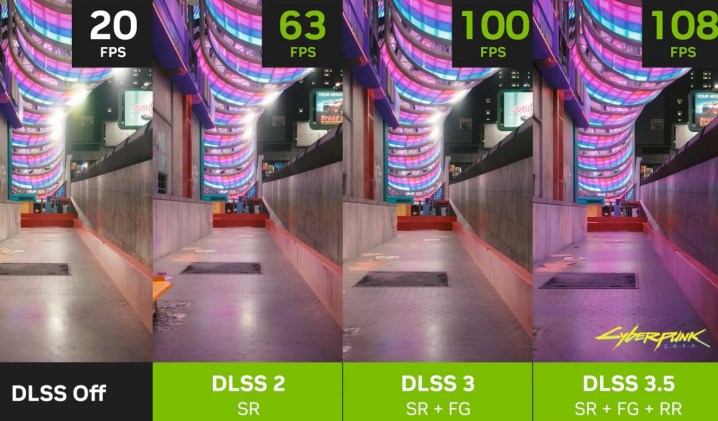
The only games currently announced with DLSS 3.5 are Cyberpunk 2077, Portal RTX, and Alan Wake 2. At least with the first two, we know the games use path tracing and rely on DLSS 3 to maintain playable performance. Alan Wake 2 is a mystery, though we know the game will use a lot of ray-traced effects and leverage DLSS Frame Generation. It might be a similar situation with that game.
In addition, Nvidia suggests that Ray Reconstruction will benefit intensive ray tracing the most. I wasn’t able to test how it worked with lower
For what we have now, though, DLSS 3.5 is an impressive update that delivers exactly what Nvidia promised. That’s assuming you have the requisite hardware to take advantage of it.
Editors' Recommendations
- New Nvidia update suggests DLSS 4.0 is closer than we thought
- Nvidia DLSS is amazing, but only if you use it the right way
- I hope Nvidia never makes an RTX 5090
- When a high frame rate can lose you the game
- Alan Wake 2 on PC is an embarrassment of riches



